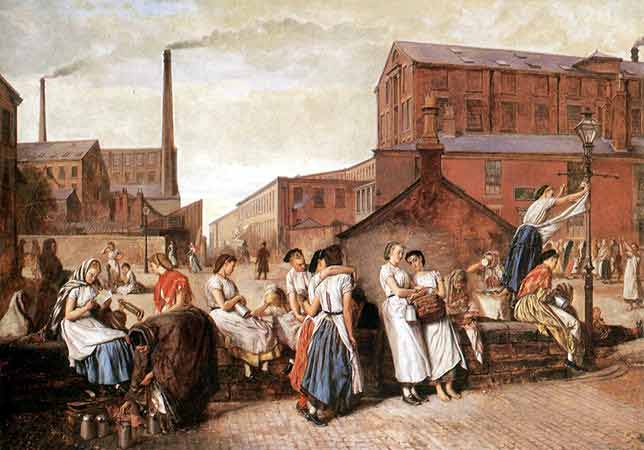Power: Steel, Steam and Politics
The March of the MachineHow long can men thrive between walls of brick, walking on asphalt pavements, - Charles Lindbergh History suggests that capitalism is a necessary condition for political freedom. Clearly it is not a sufficient condition. - Milton Friedman
Population in Cities by 1850 The Industrial Revolution set the tone for the 19th century. It was a gradual process that marked the beginning of the modern age. The British were the main innovators, which took their country from an agricultural to an urban industrial economy. From England, the revolution spread out through Europe and to the US. The norm that land was the main source of wealth was completely changed during this time. Unlike the French, who were wedded to mercantilism, England had developed a system where they did not direct and tightly control their economy; they embraced free-market practices. Thus, workers were able to form their own companies. Another differentiating influence for England was geography. Unlike other European countries, England had suffered no war damage. They had stability. Thanks to the English Channel and their naval superiority, England has been safe for years. They possessed something that most other countries did not have – the freedom to amass great wealth without threat of invasion. They were ripe for innovation. By that point, England had established a colony in India and were bringing back quantities of cotton. There was a huge market for cotton goods in England, but a bottleneck existed due to the primitive manufacturing techniques that existed at the time - spinning wheels and looms were operated by hand making the process slow and expensive. Thus, only the upper classes could afford cotton goods. Finally, someone found a way to harness water power to spin and loom. Factories appeared along rivers (the source of abundant water). This increased production improved the quality of life for the lower class because they now had comfortable clothes they could easily wash. They could also now afford the luxury of underwear. The source of water being rivers, factories were limited by geographical constraints. The search was on for a better source of power. In 1763, Scotsman James Watt was sent a Newcomen steam engine to repair. (Steam engines up to that point had been dangerous, inefficient and unreliable devices, used mostly in coal mining to pump water out of mines.) While putting it back into working order, Watt discovered how he could make the engine more efficient. He worked on the idea for several months and eventually produced a steam engine that cooled the used steam in a condenser separate from the main cylinder, which was connected to the cylinder by a valve. Watt was not a wealthy man so he decided to seek a partner with money (on the continent, it would have been the government who stepped in to help). John Roebuck, owner of a Scottish ironworks, agreed to provide financial backing. But Roebuck went bankrupt in 1773, so Watt took his ideas to Matthew Boulton, a successful businessman from Birmingham. For the next 11 years Boulton's factory produced and sold Watt's steam-engines, mainly for colliery owners who used them to pump water from their mines. Watt's machine was very popular because it was four times more powerful than previous engines. Initially, only engines in coal mines benefited from the new design but, since this meant more coal was available to run more steam engines, factories could begin to move away from rivers. One of Watt's steam-engines was purchased by John Wilkinson, who used it in his blast furnace. Wilkinson helped Watt improve his engine by developing a boring machine that was able to drill cylinders to a high standard of accuracy. Steam engines then allowed coke to be made from coal, which brought about increased production of high-quality steel. Watt continued to experiment and by 1782 had produced a rotary-motion steam engine. His machine now drove on both the forward and backward strokes of the piston and a sun-and-planet gear produced rotary motion. Whereas his earlier machine, with its up-and-down pumping action, was ideal for mines, this new engine could drive many types of machinery. Richard Arkwright was quick to importance of this new invention, and in 1783 began using it in his textile mill. Others followed his lead. By 1800 there were over 500 of Watt's machines in Britain's mines and factories. In 1755 Watt had been granted a patent by Parliament that prevented anybody else from making a steam-engine like the one he had developed. For the next 25 years, the Boulton & Watt company had a virtual monopoly over the production of steam-engines. Watt charged his customers a premium for using his steam engines. To justify this he compared his machine to a horse. Watt calculated that a horse exerted a pull of 180 pounds, therefore, when he made a machine, he described its power in relation to a horse, that is "a 20 horse-power engine". Watt worked out how much each company saved by using his machine rather than a team of horses. The company then had to pay him one 1/3 of this figure every year, for the next 25 years.
Industrial Revolution Watt's engine helped bring about the Industrial Revolution and revolutionised England. The production of steel went from 17,000 tonnes in 1740 to more than 3 million tonnes in 1840. Steel plus steam also allowed for the very important development of the railway. First, rails allowed handcarts filled with coal to be moved about easier in the mine. But as steam engines got smaller and more efficient, steam trains became possible. In 1825, George Stephenson built the first commercial engine. It had a top speed of 18 miles per hour – which seemed quite fast to the people of the day – and, unlike horses, the steam engine never seemed to get tired. The train brought great social and economic consequences with it. Transportation was improved exponentially - goods arrived much faster and safer than ever before. Freight was cheaper. Factories could be made larger because they could now be supplied with sufficient raw materials. Plus the railroads had a huge infrastructure – stations were built in every town along the way. Sleeping cars meant people could now take long journeys in comfort. The US was the next country after England to fully embrace railroads. As much effort was put into the construction of railroads and trains as had been put into the construction of the pyramids in ancient Egypt. Socially, they spurred the growth of an urban working class. Travel was much easier - so manpower was more plentiful: anyone who thought they had nothing to gain by staying on the farm headed for the nearest railroad station, and, with hope of a job, into the city. The success of the industrial revolution in England culminated in a flashy exhibition in 1851 in London, done to allow England to impress her own citizens and (mainly) the rest of the world with her success. The exhibit was held in the Crystal Palace, built specifically for the occasion out of steel and glass. It was a showplace for new technological innovations, a shining jewel, a place of wonder where anything was possible. At that time, England was producing 2/3 of the world’s coal, ½ of the world’s iron and 1/5 of their manufactured goods.
Crystal Palace Finally, the Napoléonic Wars having finally ended, the rest of Europe began to play catchup to England's head start on the industrial revolution. Since most of Europe had been busy fighting with or against Napoléon, they were way behind times; however, catching up was easier for them than the original advancements had been for England as the State provided backing and countries shamelessly copied England’s existing technology. Nevertheless, by 1900, England had still managed to maintain the lead, closely followed by America. (The US was more open to technology than was the continent.) A unified German state was in 3rd place, while France was 4th. The further east one went, the more the countries seemed to be stuck in the past; less industry and more agriculture appeared. The western end of Europe was playing the industrial game, and catching up fast, but Russia still had serfs and peasants and was reluctant to break from tradition. They were therefore in worse straits at the beginning of the 20th century than other countries – one of the main reasons why they embraced communism. Russia’s main export was, and had always been, grain. The Tsar saw no need to change anything. Then.
Advantages of the Industrial Revolution
One of the many inventions of this era was the telegraph, first developed by Samuel F B Morse in the 1840s. This was the first major increase in the speed of information exchange in centuries. (By 1870, a telegram could travel around the world in just a few hours.) Later, Graham Bell invented the telephone. The industrial revolution essentially shrank the world by removing its reliance on animal power, not only for travel but for communication. Previously, horses and boats had handled all transportation and communication for millennia. Plumbing and the invention of elevators allowed unlimited urban growth. In 1800, 17 cities had a population of 100,000 or more. By 1900 there were at least 13 cities with more than a million inhabitants. The main opponents of the industrial revolution were the Romanticists, the literary community (including, for example, Blake and Wordsworth) which mainly focused on the environmental damage done by the industrial revolution, perhaps a backward way of looking at things. Dickens wrote mainly of its inequities and negative effects. Many other writers focused on the destruction of rural life and the disappearance of the noble savage. Indeed, the well-known London fog, for instance, was responsible for the poor health, and even the death, of many – and the fog was a product solely of the Industrial Revolution. Thomas Malthus and David Ricardo were partially economists, partially sociologists. They felt that the industrial boom could not be sustained and that the damage to the environment was ultimately damaging for everyone. Malthus was the first real advocate of population control. He thought (wrongly, as it turned out at the time) that production could never keep up with population growth - one was linear while the other was exponential. Ricardo felt that the lower class would always be a permanent underclass – the industrial revolution had produced a form of serfdom, people were, in essence, being punished for being poor in addition to having poor working conditions and a dirty environment due to an unregulated workplace. Around this time, Darwin came up with his evolutionary theories, which gave rise to the concept that only the best workers should be bred to increase production efficiency.
Cripples in the Yard of the Children's Home in London Unguarded machinery was a major problem for children working in factories. One hospital reported that every year it treated nearly 1,000 people for wounds and mutilations caused by machines in factories. A report commissioned by the House of Commons in 1832 said that: "there are factories, no means few in number, nor confined to the smaller mills, in which serious accidents are continually occurring, and in which, notwithstanding, dangerous parts of the machinery are allowed to remain unfenced." The report added that he workers were often "abandoned from the moment that an accident occurs; their wages are stopped, no medical attendance is provided, and whatever the extent of the injury, no compensation is afforded." In 1842 a German visitor noted that he had seen so many people in the streets of Manchester without arms and legs that it was like "living in the midst of the army just returned from a campaign." Little girls as young as 7,were hired as "scavengers" to collect from the factory floor flying fragments of cotton while the machinery passed over her. If she was careful and kept her head, body and outstretched limbs carefully glued to the floor, the machine's moving parts could pass over her head and trembling body without touching it. But accidents frequently occurred - many were the flaxen locks rudely torn from infant heads.
Finally, after about 50 years, people began to feel that they had had enough, and reform laws began to be passed, especially by the Earl of Shaftesbury, an MP in parliament. Initially, women and children were forbidden from working in coal mines; later, a 10-hour-per-day cap was put on worker hours. Workers’ unions, previously banned, became legal and workers were allowed to assemble to air their grievances. Not all factory owners were avaricious. One, Robert Ulwin, was well-known for keeping his workers happy. America, on the other hand, was locked into the laissez-faire tradition, so reform movements took longer to form there. It was only in the first few decades of the 20th century that they finally removed such things as child labour, which Britain had done some 80 years prior. In England, environmental reforms began and health standards improved. The first reforms included the advent of city sewage and piped-in clean water. Louis Pasteur, a French chemist, had developed the germ theory of disease; he said it was germs, not dirt, which caused illnesses and plague. Therefore, a more intense cleanup of the environment was needed for the betterment of all. He revolutionised food production as well, leading to the pasteurisation of dairy products. His work caused English surgeon Joseph Lister to experiment with ways to sterilise surgical equipment. He developed the use of carbolic acid as an antiseptic and, later, the use of gauze and hospital gowns. This led to a major decrease in the urban death rate, as living and working conditions were constantly improving. The biggest opposition to the industrial revolution, however, was political radicalism, specifically Marxism. Adam Smith had developed a “scientific” approach to economics. Nascent sociologists were developing a “scientific” approach as well. In 1848 Karl Marx and Friedrich Engels published their treatise against the industrial revolution called the Communist Manifesto. This was essentially an attack on capitalism and advocated: "the overthrow of the bourgeoisie, the domination of the proletariat, the abolition of the old bourgeois society based on class antagonisms, and the establishment of a new society without classes and without private property…" They advocated to workers, “You have nothing to lose but your chains…”
Marx and Engels essentially felt that the rise of the industrial revolution and the triumph of the Bourgeoisie was inevitable from the beginning of history, because it was needed to replace feudalism. They felt history was entirely written by injustice, not as the works of great people. Economics drives history. Just as Feudalism was overthrown, capitalism would be overthrown too by the proletariat in a glorious revolution and a new age would begin of total equality. There would be no private property, no inherited wealth, no “profiting” by anybody, state control of communication, cities would be removed and people would be evenly distributed across the landscape so that there would be no distinction between town and country. This would be socialism. Eventually, government would become unnecessary, socialism would die out, and communism would begin – but one doesn’t go from socialism to communism until the government withers and dies, which is why, diehards feel, their ideas haven’t really been disproved by the disasters in China and Russia. Anarchists, more militant and violent, wanted to get rid of government immediately. This distinguished them from communists, who felt that socialism must come first. Marx felt that communism must come about by revolution, but did not advocate immediate revolution, as he felt it could only work if revolution happened inevitably, when the time was right. New movements started from Marx’s ideas that didn’t quite share his viewpoint. Socialists had beliefs similar to Marx, but felt that revolutions were not needed, that changes for the better could be made gradually, leading to a perfect society. The Labour Party in Britain was the pre-eminent workers’ party, inspired at first by Marx’s theories. Labour wanted more state control. It is the number one party in Britain today, but has had to adjust its policies to get there. America was slow to embrace those ideas. Socialist movements were never popular in the United States. The final consequence of the industrial revolutions worth a mention is that it had a ripple effect over the Asia world. It had jumpstarted colonidation with the steamship and consequent rapid travel. People could get to more distant places than ever before – and in a reasonable time. This made a large portion of Asia accessible that had not been before - China, for one. Up until then, China had only allowed foreigners into a single port city, Canton, and Japan was completely shut off to all. The British had tried in 1790 to see the Chinese emissary but were told that China lacked nothing and so needed nothing – certainly not from the barbaric Brits. By the end of the 18th century, Britain was getting tired of not being allowed to enter China. Finally, in the 19th century, they hit on something the average Chinaman seemed to want - opium. Before long, there was a huge demand. The Chinese Emperor got sick of his subjects being addicted to opium. The substance was banned. Chinese soldiers sunk British ships that entered Chinese territory carrying it. This annoyed Britain and they declared war. Thus did the Opium Wars (1839 – 1842) begin. Opium Massacre may have been a better term – the British crushed China utterly with their new weapons and technology – China had no chance at all. China was forced to open their country up to trade with Britain, who could now visit wherever in China they wished to go. Britain also received the port of Hong Kong for 100 years. The terms of China's defeat caused other countries to want their share. They demanded the same rights under threat of war. There was a period of free-for-all with countries grabbing islands to be used by their ships as refueling stations for their coal-fired ships. The French snagged Indochina. By the end of the 19th century, most of East Asia was under British colonial control. Only Japan was not victimised in this way. Japan had been shut off for many years, but seeing what happened to China, they decided that they needed to get modernised at express speed. They shed traditions and adopted European systems. They underwent the most rapid form of industrialisation possible. This was known as the Meiji Restoration (1868). Soon, Japan became the pre-eminent Asian country.
For more on modern history including both widely-known and little-known facts, opinions (mine and others), a few political cartoons, some photos, a map or two, rants, politicians,
geology, speculation and more, click the "Up" button below to take you to the Index for this History section. |
 Animals
Animals Animation
Animation Art of Playing Cards
Art of Playing Cards Drugs
Drugs Education
Education Environment
Environment Flying
Flying History
History Humour
Humour Immigration
Immigration Info/Tech
Info/Tech Intellectual/Entertaining
Intellectual/Entertaining Lifestyles
Lifestyles Men
Men Money/Politics/Law
Money/Politics/Law New Jersey
New Jersey Odds and Oddities
Odds and Oddities Older & Under
Older & Under Photography
Photography Prisons
Prisons Relationships
Relationships Science
Science Social/Cultural
Social/Cultural Terrorism
Terrorism Wellington
Wellington Working
Working Zero Return Investment
Zero Return Investment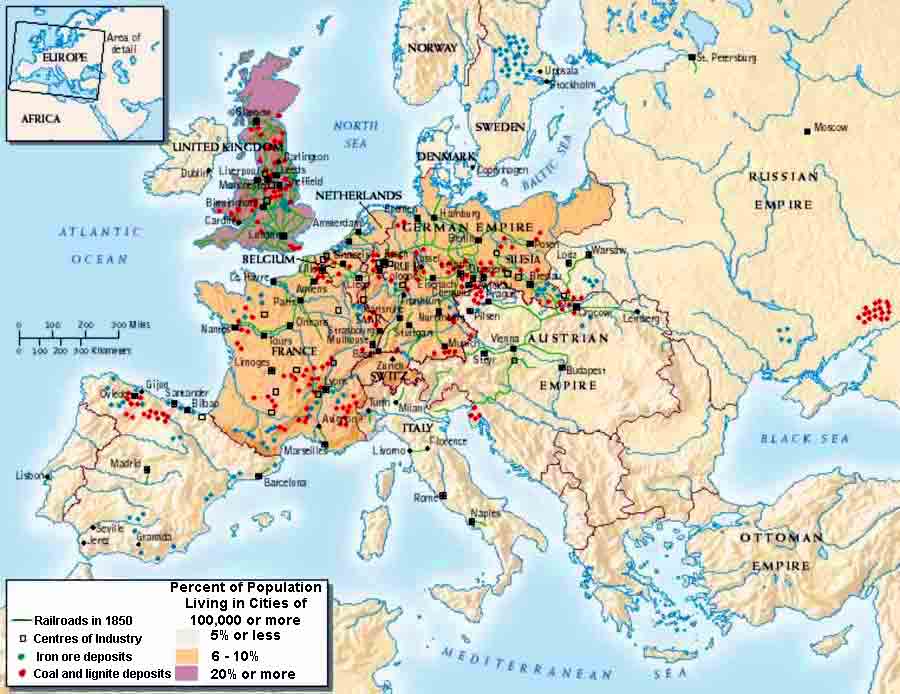

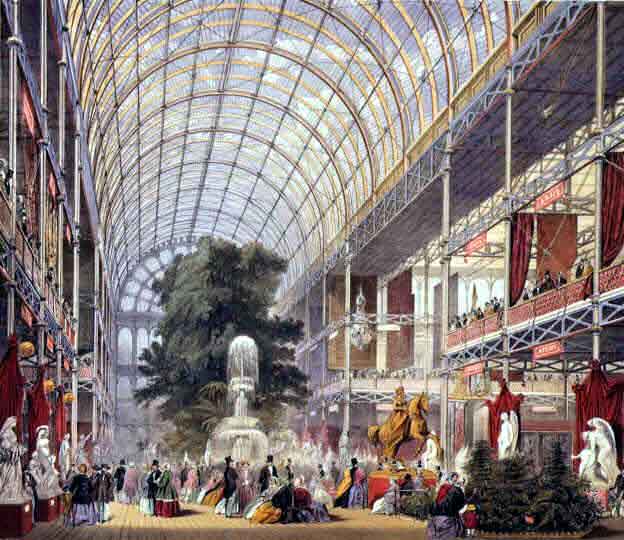
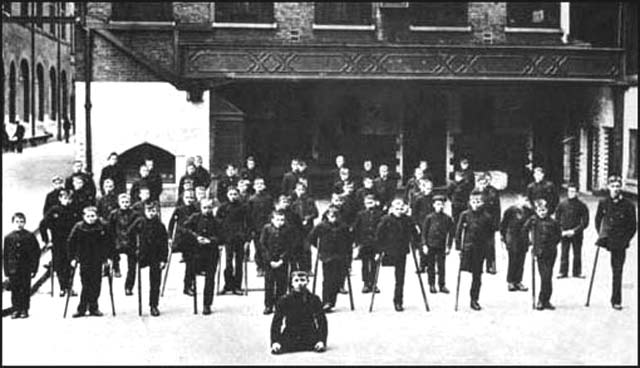
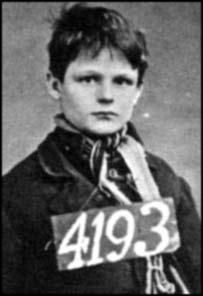 Due to a complete lack of government control on
the economy, companies were able to hire and treat workers however they liked. Initially, orphans and paupers were hired for the worst jobs. Children who worked long hours in the
mills became very tired and found it difficult to maintain the speed required by the overlookers. Children were usually hit with a strap to make them work
faster; in some factories they were dipped head first into the water cistern if they became drowsy. They were also punished for arriving late for work and
for talking to the other children. Parish apprentices who ran away from the factory were in danger of being sent to prison (like the boy at left). Children
who were considered potential runaways were placed in irons. When laws were finally passed limiting such actions, families members were forced to help out to meet
quotas. This, combined with a decrease in opportunity due to previously established businesses maintaining a monopoly in their fields (being by 1840 basically closely-held
family business passed down to heirs), caused the chances of gaining wealth far a member of the lower class to be virtually nil.
Due to a complete lack of government control on
the economy, companies were able to hire and treat workers however they liked. Initially, orphans and paupers were hired for the worst jobs. Children who worked long hours in the
mills became very tired and found it difficult to maintain the speed required by the overlookers. Children were usually hit with a strap to make them work
faster; in some factories they were dipped head first into the water cistern if they became drowsy. They were also punished for arriving late for work and
for talking to the other children. Parish apprentices who ran away from the factory were in danger of being sent to prison (like the boy at left). Children
who were considered potential runaways were placed in irons. When laws were finally passed limiting such actions, families members were forced to help out to meet
quotas. This, combined with a decrease in opportunity due to previously established businesses maintaining a monopoly in their fields (being by 1840 basically closely-held
family business passed down to heirs), caused the chances of gaining wealth far a member of the lower class to be virtually nil.